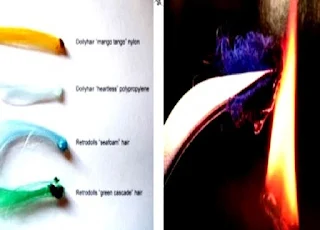APPLICATIONS OF FIBRES
The textile industries are developing at a rapid rate
with the manufacture of different types and different functional textiles. This
chapter deals with the identification of fibers and indicates various. Applications
of textile materials.
IDENTIFICATION OF TEXTILE FIBRES
Fibers broadly can be classified into organic and
inorganic types. However, most of the fiber-forming polymers are of organic
origin. They may also be either thermoplastic or thermosetting in nature which
determines
their solubility and fusibility behaviors. Due to their
organic nature most of the polymers are inflammable and during the burning show
specific characteristics depending upon the nature of the polymer. Fibers or
polymers owe their specific properties to their unusual large molecular size,
consisting of small repeating units.
Owing to this they resemble lower molecular weight
compounds and reactivity of the functional groups remain unchanged in polymers.
So the polymers can be identified by normal functional group analysis. Thus,
identification of polymers is possible by their burning characteristics aided
by elemental analysis and solubility behavior. This approach is inexpensive,
simple and requires very little time. Once the nature of the polymer is known,
then further characterization is possible by more sophisticated methods.
There are different types of tests to identify the
textile fibers. The different tests can be summarized as:
Tests Non-technical tests Technical tests
- Feeling test Microscope test
- Burning test Density measurement
- Staining test Chemical test
FEELING TEST
Different fibres show different behavior when you will
place your hand on them. Details of the feeling test are mentioned in Table Feeling
Characteristics of the Fibres Cool to touch feels soft and inelastic Cool to touch,
feels smooth and leathery Cool to touch, feels smooth and leathery Warm to
touch feels elastic and smooth Warm to touch, feels elastic and springy Cool
to touch feels smooth, inelastic and lustrous Cotton Linen Jute Silk Wool
Rayon more elastic and resilient
Different fibres show different behavior when you will place your hand on them. Details of the feeling test are mentioned in Table Feeling
Different fibres show different behavior when you will place your hand on them. Details of the feeling test are mentioned in Table Feeling
Characteristics of the Fibres
- Cotton - Cool to touch, feels soft and inelastic
- Linen - Cool to touch, feels smooth and leathery
- Jute - Cool to touch, feels smooth and leathery
- Silk - Warm to touch, feels elastic and smooth
- Wool - Warm to touch, feels elastic and springy
- Rayon - Cool to touch, feels smooth, inelastic and lustrous
- Acetate Nylon - Little warm to touch, feels smoother, more elastic
and resilient than rayon
- Nylon - Feels very smooth, lightweight, elastic, lustrous
- Polyester - Feels very smooth and stiffer
- Acrylic - Feels like wool, but lightweight and slippery feeling
- Polypropylene - Extremely lightweight, resilient smooth and lustrous
BURNING TEST
To identify the fibres by burning the test, the sample
should be moved slowly towards a small luminous flame. The burning rate and
burning characteristics, after it is removed from the flame, should be noted.
The fibres can be identified by the observations mentioned in Table
Burning Characteristics of Fibres
Cellulosic Fibres Cotton, Jute Flax, Viscose
Burns with little ash and yellow flame, odor similar
to that of burned paper.
Wool
Burns slowly with slight sizzle and ceases flaming when
the fire is withdrawn. The color of the flame is yellow-orange with blue or
purple bottom edges. The ash is dark and crisp. It can be crushed easily with
fingers. The odor is like burning human hair or feather.
silk
Burns readily with light sizzle. The flame is orange-yellow color and blue-grey smoke. The flame sparkles, the fiber swells, and
chars. The odor is like burning human hair.
Casein
On exposure to flame, the fibre swells, burns, and chars
with yellow color and grey smoke. The odor is like burning the milk.
Acetate fibre
The sample fuses with yellow, mauve or blue-base
color melts into a hard mass. Acetate Fibres The ash is hard and brittle and it is difficult to crush odor is like that of vinegar. between the fingers.
Nylon
The sample fuses and shrinks away from the flame burns
slowly with the yellow, orange or blue bottom with melting. Forms round, furnish brittle, hard black bead. On melting the odor will fresh celery burning
vegetation.
Polyester
The fibre softens, melts with a yellow-orange color and
black smoke with sweet aromatic odor and shrinks away from the flame. Forms
irregular hard bead.
Polyester
The sample fuses and shrinks away from flame melts,
burns vigorously leadıng a hard, dark brittle residue.
Acrylic
Will not burn, ignited giving negligible color or
yellow sodium flame in case of Glass A fibers. Glass







